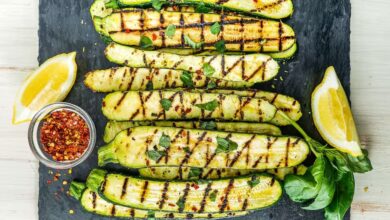Ram Navami Fasting Guidelines: What to Do and What Not to Do
Ram Navami is a global Hindu holiday that is widely observed to honor the birth of Lord Rama, who is the seventh incarnation of Lord Vishnu. Ram Navami falls on April 17 this year. Fasting, which is very important in the life of devotees, is one of the traditions at the center of this festival.

It is said that fasting on Ram Navami expresses devotion to Lord Rama and purifies the body, mind, and soul. On this auspicious day, there are certain dos and don’ts when it comes to fasting, just as with any religious practice. Let’s investigate:
Don’ts:
Get up early: It is advised that during the Brahma-muhurta, devotees awaken early in the morning (about 1.5 hours before dawn). It is recommended that devotees start their days with morning rituals like as taking a bath, putting on clean clothing, and praying to Lord Rama.
Maintain Hydration: Staying hydrated throughout the day requires consuming a lot of water and other liquids, particularly if you are fasting. Herbal teas, fruit juices, and coconut water may also support proper hydration.
Consume Foods High in Nutrients: Choose foods high in nutrients, such as fruits, vegetables, nuts, and dairy products, to make sure you obtain the vitamins and minerals you need when fasting.
Exercise Moderation: If you decide to have a meal to break your fast, proceed with caution. Your digestive tract may experience pressure if you overeat after a day of fasting. Start with modest serving sizes.
Add Sources of Protein: Include foods high in protein in your meals, such as lentils, beans, tofu, or paneer, to aid in muscle repair and prolong feelings of fullness and satisfaction.
Select Whole Grains: If you’re not on a fast, make sure your meals include whole grains like quinoa, brown rice, and whole wheat. These grains are high in fiber, which supports digestive health, and they release energy gradually.
Avoid:
Eating Meals That Are Not Vegetarian: During the Ram Navami fast, it is completely forbidden to consume non-vegetarian food. It is expected of devotees to eat only vegetarianism.
Indulgence in Luxuries: Observing a fast on Ramadan Navami involves more than simply giving up eating; it also involves practicing frugality and simplicity. On this day, devotees abstain from worldly pleasures and luxury.
Eat Less Sugary Foods: Try to restrict your consumption of sugary delicacies, even if it may be tempting to overindulge in pastries and sweets during celebrations. Consuming too much sugar might cause blood sugar imbalances and energy collapses.
Reduce Your Intake of Fried meals: Fried meals may be particularly heavy on the stomach, especially after fasting, and are often rich in harmful fats. Instead of consuming as many deep-fried treats, try baking, grilling, or steaming as healthier cooking techniques.
Steer clear of heavy and spicy meals: heavy and spicy foods, particularly after a day of fasting, may aggravate the digestive system. Choose easier-to-digest, milder, lighter foods.
Avoid Processed Foods: Foods rich in additives, harmful fats, and salt, such as chips, packaged snacks, and rapid meals, should be avoided. Whenever feasible, choose whole, unprocessed meals to promote general health and wellbeing.
After Breaking the Ram Navami Fast, What To Have?
Adherents partake in a straightforward and sattvic (pure) meal after the breaking of the fast observed on Ram Navami. The following are some customary foods that are often eaten to break the fast:
Fruits: A common option to break the fast is fresh fruit, such as bananas, apples, oranges, grapes, and mangoes. After a day of fasting, they are simple to digest and provide vital nutrients and moisture.
Milk and Milk Products: After breaking the fast, people often eat dairy products such buttermilk, yoghurt, and milk. They are high in vitamins, calcium, and protein, all of which support healthy digestion and energy restoration.
Desserts: Jaggery, coconut, and nut-based sweet foods are lucky for breaking the fast. Ladoos, kheer (rice pudding), halwa, and peda are popular desserts.
Chickpeas, or chana A South Indian meal called sundal is created with boiling chickpeas with spices, coconut, curry leaves, and mustard seeds. It’s a great option after fasting since it’s light, nourishing, and easily digested.
Sabudana Khichdi: A meal consisting of prepared and soaked tapioca pearls, sautéed with potatoes, peanuts, and seasonings.
Recipes Using Potatoes: After fasting, simple potato meals such mashed or boiled potatoes seasoned with black pepper, rock salt, and cumin are also often eaten. They provide the body with energy and carbs without taxing the digestive system.
Vegetable Dishes: Nutritious alternatives for breaking the fast include light vegetable curries or stir-fries prepared with vegetables like spinach, bottle gourd, pumpkin, or ridge gourd. They provide vital vitamins and minerals and are simple to digest.
Rice: Another satisfying choice for breaking the fast is plain steamed rice or khichdi, a blend of rice and lentils, eaten with a dab of ghee (clarified butter). It is easy on the stomach and provides energy in the form of carbs.
Finally, after breaking the fast, it is customary to present and eat prasad, or blessed food. Any food item that is first presented to the god and then shared among family members might be included in this.
After breaking the fast, devotees may refuel their bodies, regain their energy, and go on honoring the ancient tradition of Ram Navami with appreciation and devotion by eating these easy and nourishing delicacies.







